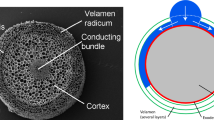Abstract
The relative volume of internal gas spaces (i.e., porosity) of the shoot and roots of a plant largely determines its resistance to flooding, as oxygen may diffuse through these cavities from non-flooded parts of the plant into the submerged tissues. The current techniques to measure porosity either need relatively large amounts of plant tissue (200 mg per sample), or are time-consuming and not sufficiently accurate for specific types of plant material. These limitations were the reason to develop a new method of porosity measurement. Small segments of roots were taken from freshly harvested plants, placed in a two-piece hard gelatin capsule and weighed on a microbalance. The root segments were subsequently infiltrated with water under vacuum, blotted carefully and weighed again. Using the increase in weight and the specific weight of infiltrated tissue, derived from a larger sample of roots, it was possible to calculate the porosity of individual root segments as small as 3–5 mg with a length of 5 mm. The new method combines this use of small samples with a high accuracy, and proved useful for a variety of plant species. Porosity data obtained with this method will improve our knowledge of small-scale processes such as aerenchyma development in root tips.
Similar content being viewed by others
References
Armstrong W 1972 A re-examination of the functional significance of aerenchyma. Physiol. Plant. 27, 173–177.
Armstrong W 1979 Aeration in higher plants. In Advances in Botanical Research, Vol. 7. Ed. H W Woolhouse. pp. 225–332. Academic Press, London.
Armstrong W 1993 Methods of comparative study – aerenchyma, intercellular gas-space and aeration. In Methods in Comparative Plant Ecology: A Laboratory Manual. Eds G A F Hendry and J P Grime. pp. 29–32. Chapman & Hall, London.
Aulakh M S, Wassmann R, Rennenberg H and Fink S 2000 Pattern and amount of aerenchyma relate to variable methane transport capacity of different rice cultivars. Plant Biol. 2, 182–194.
Barber D A, Ebert M and Evans N T S 1962 The movement of 15O through barley and rice plants. J. Exp. Bot. 13, 397–403.
Canny M J and Huang C X 1993 What is in the intercellular spaces of roots? Evidence from the cryo-analytical-scanning electron microscope. Physiol. Plant. 87, 561–568.
Drew M C, Jackson M B and Giffard S 1979 Ethylene-promoted adventitious rooting and development of cortical air spaces (aerenchyma) in roots may be adaptive responses to flooding in Zea mays L. Planta 147, 83–88.
Gibberd MR, Gray JD, Cocks PS and Colmer TD 2001 Waterlogging tolerance among a diverse range of Trifolium accessions is related to root porosity, lateral root formation and 'aerotropic rooting'. Ann Bot 88, 579–589.
Jackson M B and Drew MC 1984 Effects of flooding on growth and metabolism of herbaceous plants. In Flooding and Plant Growth. Ed. T T Kozlowski. pp. 47–128. Academic Press, New York.
Jensen C R, Luxmoore R J, Van Gundy S D and Stolzy L H 1969 Root air space measurements by a pycnometer method. Agron. J. 61, 474–475.
Justin S H F W and Armstrong W 1987 The anatomical characteristics of roots and plant response to soil flooding. New Phytol. 106, 465–495.
Justin S H F W and Armstrong W 1991 Evidence for the involvement of ethene in aerenchyma formation in adventitious roots of rice (Oryza sativa L.). New Phytol. 118, 49–62.
Kawase M 1981 Anatomical and morphological adaptations of plants to waterlogging. Hort. Sci. 16, 30–34.
Kawase M and Whitmoyer R E 1980 Aerenchyma development in waterlogged plants. Am. J. Bot. 67, 18–22.
Laan P, Berrevoets M J, Lythe S, Armstrong W and Blom C W P M 1989 Root morphology and aerenchyma formation as indicators of the flood-tolerance of Rumex species. J. Ecol. 77, 693–703.
Raskin I 1983 A method for measuring leaf volume, density, thickness, and internal gas volume. Hort. Sci. 18, 698–699.
Rijnders J G H M, Armstrong W, Darwent M J, Blom C W P M and Voesenek L A C J 2000 The role of oxygen in submergence-induced petiole elongation in Rumex palustris: in situ measurements of oxygen in petioles of intact plants using micro-electrodes. New Phytol. 147, 497–504.
Thomson C J, Armstrong W, Waters I and Greenway H 1990 Aerenchyma formation and associated oxygen movement in seminal and nodal roots of wheat. Plant Cell Environ. 13, 395–403.
Van Noordwijk M and Brouwer G 1988 Quantification of air-filled porosity: a comparison of two methods. Plant Soil 111, 255–258.
Visser E J W, Blom C W P M and Voesenek L A C J 1996a Flooding-induced adventitious rooting in Rumex: morphology and development in an ecological perspective. Acta Bot. Neerl. 45, 17–28.
Visser E J W, Cohen J D, Barendse G W M, Blom C W P M and Voesenek L A C J 1996b An ethylene-mediated increase in sensitivity to auxin induces adventitious root formation in flooded Rumex palustris Sm. Plant Physiol. 112, 1687–1692.
Visser E J W, Colmer T D, Blom C W P M and Voesenek L A C J 2000 Changes in growth, porosity, and radial oxygen loss from adventitious roots of selected mono-and dicotyledonous wetland species with contrasting types of aerenchyma. Plant Cell Environ. 23, 1237–1245.
Watkin E L J, Thomson C J and Greenway H 1998 Root development and aerenchyma formation in two wheat cultivars and one triticale cultivar grown in stagnant agar and aerated nutrient solution. Ann. Bot. 81, 349–354.
Author information
Authors and Affiliations
Corresponding author
Rights and permissions
About this article
Cite this article
Visser, E.J., Bögemann, G.M. Measurement of porosity in very small samples of plant tissue. Plant and Soil 253, 81–90 (2003). https://doi.org/10.1023/A:1024560322835
Issue Date:
DOI: https://doi.org/10.1023/A:1024560322835




